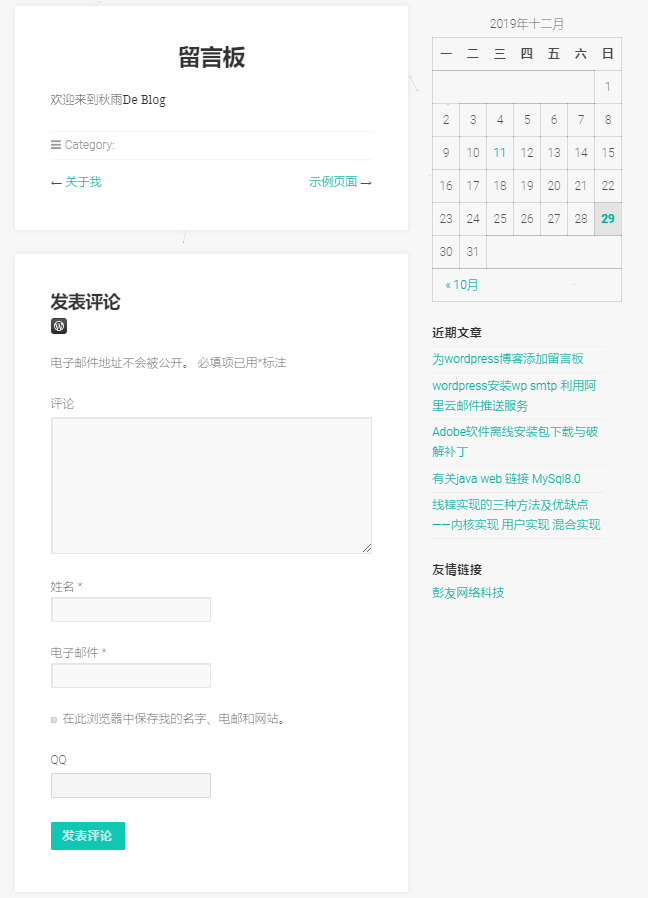wordpress本身并没有留言板共功能,需要我们自己使用插件或者新建留言模板的方式来更改。这里介绍的是新建留言模板。
首先我们要复制一个你的网站页面的模板,在wp-content/themes/你的主题名文件夹里面的single.php模板文件,将其复制一份,将其更名为guestbook.php。打开文件加入一段注释,来告诉wordpress这是一个模板文件
<?php
/*
Template Name: Guestbook
*/
?>将其上传到到 wp-content/themes/你的主题名 文件夹里面,然后来到博客后台,新建一个页面,在页面属性选择新建的 guestbook 模板然后选择发布就能看到自己建立的留言板.

可以发现此时的留言板并不像一个留言板反而像一个文章页面,所以我们需要对其进行更改,由于每个模板文件结构不一样,所以关于文件位置只介绍大概,在新建的gusetbook.php里有一个get_template_part()带的参数是一个loop-post文件
<?php get_template_part( 'content/loop', 'guset' ); ?>我们找到文件位置,新建一个文件 命名为loop-guset.php,并对其进行更改,让他更适合留言板
在 loop-guset .php文件里有一个函数
<?php if ( comments_open() || '0' != get_comments_number() ) { comments_template(); } ?>这里的comments_template可以带一个参数指定文件,默认的为comments.php文件,所以我们按部就班,将其赋值一个命名为guestcomments.php文件,并在函数comments_template()里对其调用
<?php if ( comments_open() || '0' != get_comments_number() ) { comments_template('/guestcomments.php'); } ?>我们打开 guestcomments.php文件 我们只需要在后面对comment_form()函数对其赋值。
comment_form()函数官方文档对其参数解释:
原文档
Description #Description
Most strings and form fields may be controlled through the $args array passed into the function, while you may also choose to use the ‘comment_form_default_fields’ filter to modify the array of default fields if you’d just like to add a new one or remove a single field. All fields are also individually passed through a filter of the ‘comment_form_field_$name’ where $name is the key used in the array of fields.
Parameters #Parameters
$args
(array) (Optional) Default arguments and form fields to override.
- 'fields'
(array) Default comment fields, filterable by default via the 'comment_form_default_fields' hook.- 'author'
(string) Comment author field HTML. - 'email'
(string) Comment author email field HTML. - 'url'
(string) Comment author URL field HTML. - 'cookies'
(string) Comment cookie opt-in field HTML.
- 'author'
- 'comment_field'
(string) The comment textarea field HTML. - 'must_log_in'
(string) HTML element for a 'must be logged in to comment' message. - 'logged_in_as'
(string) HTML element for a 'logged in as [user]' message. - 'comment_notes_before'
(string) HTML element for a message displayed before the comment fields if the user is not logged in. Default 'Your email address will not be published.'. - 'comment_notes_after'
(string) HTML element for a message displayed after the textarea field. - 'action'
(string) The comment form element action attribute. Default '/wp-comments-post.php'. - 'id_form'
(string) The comment form element id attribute. Default 'commentform'. - 'id_submit'
(string) The comment submit element id attribute. Default 'submit'. - 'class_form'
(string) The comment form element class attribute. Default 'comment-form'. - 'class_submit'
(string) The comment submit element class attribute. Default 'submit'. - 'name_submit'
(string) The comment submit element name attribute. Default 'submit'. - 'title_reply'
(string) The translatable 'reply' button label. Default 'Leave a Reply'. - 'title_reply_to'
(string) The translatable 'reply-to' button label. Default 'Leave a Reply to %s', where %s is the author of the comment being replied to. - 'title_reply_before'
(string) HTML displayed before the comment form title. Default:<h3 id="reply-title" class="comment-reply-title">. - 'title_reply_after'
(string) HTML displayed after the comment form title. Default:</h3>. - 'cancel_reply_before'
(string) HTML displayed before the cancel reply link. - 'cancel_reply_after'
(string) HTML displayed after the cancel reply link. - 'cancel_reply_link'
(string) The translatable 'cancel reply' button label. Default 'Cancel reply'. - 'label_submit'
(string) The translatable 'submit' button label. Default 'Post a comment'. - 'submit_button'
(string) HTML format for the Submit button. Default:<input name="%1$s" type="submit" id="%2$s" class="%3$s" value="%4$s" />. - 'submit_field'
(string) HTML format for the markup surrounding the Submit button and comment hidden fields. Default:<p class="form-submit">%1$s %2$s</p>, where %1$s is the submit button markup and %2$s is the comment hidden fields. - 'format'
(string) The comment form format. Default 'xhtml'. Accepts 'xhtml', 'html5'.
Default value: array()$post_id
(int|WP_Post) (Optional) Post ID or WP_Post object to generate the form for. Default current post.
Default value: null
谷歌浏览器翻译
说明#说明
大多数字符串和表单字段可以通过传递到函数中的$args数组进行控制,同时如果你只是想添加一个新的字段或删除一个字段,你也可以选择使用'comment_form_default_fields'过滤器来修改默认字段数组。所有的字段也会单独通过'comment_form_field_$name'的过滤器,其中$name是字段数组中使用的键。
参数#参数
$ args
(array) (可选) 要覆盖的默认参数和表单字段。
- “字段”
(array) 默认评论字段,默认情况下可通过“ comment_form_default_fields”钩子进行过滤。- 'author'
(string)评论作者字段HTML。 - 'email'
(string)评论作者电子邮件字段HTML。 - 'url'
(string)评论作者URL字段HTML。 - “ cookies”
(string)评论cookie选择加入字段HTML。
- 'author'
- 'comment_field'
(string)HTML注释文本框。 - “ must_log_in”
(string)用于 "以[用户]身份登录 "消息的HTML元素。 - “ logged_in_as”
(string)用于 "以[用户]身份登录 "消息的HTML元素。 - 'comment_notes_before'
(string)HTML元素,用于在用户未登录时,在评论栏前显示的信息。默认为'您的电子邮件地址不会被公布'。 - “ comment_notes_after”(string)HTML元素,用于在textarea字段后显示信息。
- 'action'
(string) 评论表单元素id属性。默认为'commentform'。 - 'id_submit'
(string) 评论提交元素id属性。默认为'submit'。
- 'id_form'
(string)评论表单元素类属性。默认为'comment-form'。 - 'id_submit'
(string) 评论提交元素类属性。默认为'submit'。 - 'class_form'
(字符串)注释表单元素的类属性。默认为“评论形式”。 - 'class_submit'
(string) 评论提交元素名称属性。默认为'提交'。 - 'name_submit'
(string) 评论提交元素名称属性。默认为'提交'。 - 'title_reply'
(string) 可翻译的 "回复 "按钮标签。默认为'留下回复'。 - 'title_reply_to'
(string)可翻译的 "回复 "按钮标签,默认为 "给%s留下回复",其中%s是被回复的作者。默认为'Leave a Reply to %s',其中%s是被回复的评论的作者。 - 'title_reply_before'
(字符串)在评论表单标题前显示的HTML。默认值。<h3 id="reply-title" class="comment-reply-title"> - “ title_reply_after”
(字符串)在评论表单标题之后显示的HTML。默认值:</h3>。 - “ cancel_reply_before”
(字符串)在取消回复链接之前显示的HTML。 - “ cancel_reply_after”
(字符串)在评论表单标题后显示的HTML。默认值。</h3> - 'cancel_reply_link'
(string) 可翻译的 "取消回复 "按钮标签。默认为'取消回复'。 - 'label_submit'
(string) 可翻译的 "提交 "按钮标签。默认为'发表评论'。
- 'label_submit'
(string) 可翻译的 "提交 "按钮标签。默认的 "发表评论"。
- “ submit_button”
(string) “提交”按钮的HTML格式。默认值:<input name="%1$s" type="submit" id="%2$s" class="%3$s" value="%4$s" />。 - “ submit_field”
(字符串)提交按钮和注释隐藏字段周围的标记的HTML格式。默认值。<p class="form-submit">%1$s %2$s</p>其中%1$s为提交按钮标记,%2$s为评论隐藏字段。 - 'format'
(string) 注释格式。默认为'xhtml'。接受'xhtml','html5'。
默认值:array()$post_id
(int | WP_Post) (可选) 要为其生成表单的Post ID或WP_Post对象。默认为当前帖子。
默认值:null
由于我们需要做留言板,更改字段名,看起来是一个留言板,所以我们需要更改 label_submit,title_reply,comment_notes_after,comment_field这几个参数将其赋值并建立一个array,然后调用 comment_form() 函数,用以呈现我们留言板。
$comments_args = array(
// Change the title of send button
'label_submit' => __( '发表留言', 'textdomain' ),
// Change the title of the reply section
'title_reply' => __( '留言板', 'textdomain' ),
// Remove "Text or HTML to be displayed after the set of comment fields".
'comment_notes_after' => '',
// Redefine your own textarea (the comment body).
'comment_field' => '<p class="comment-form-comment"><label for="comment">留言</label><br/><textarea id="comment" name="comment" aria-required="true" style="margin: 5px 0px; height: 254px; width: 522px;"></textarea></p>',
);官方文档 comment_form() https://developer.wordpress.org/reference/functions/comment_form/
文章评论
可以啊我也去掉了。